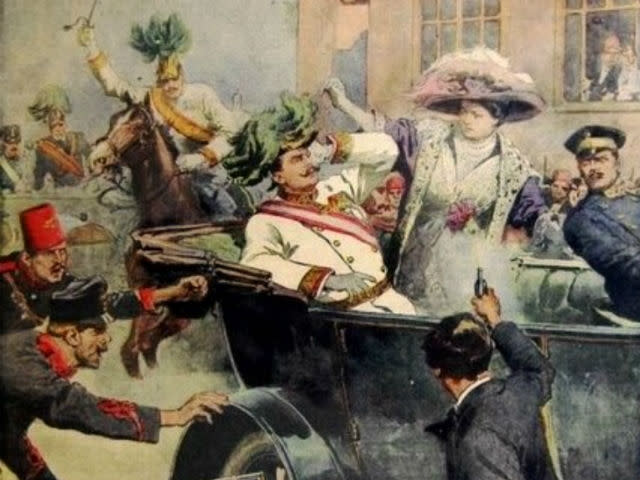The assassination that sparked World War I and the treaty that ended it

Gavrilo Princip killing Archduke Franz Ferdinand (credit: Wikimedia Commons)
There is a palace in Vienna called Schönbrunn. Sumptuous and decadent in the Baroque and Rococo styles, the Hapsburg family’s summer retreat looks not a thing like the rustic Camp David or the rambling Kennedy compound at Hyannis Port. In the 20th century, John F. Kennedy and Nikita Khrushchev would meet in the palace’s Great Gallery during the Vienna Summit. Yet before Kennedy met the Soviet premier, and his fate in Dallas, an assassination nearly a half-century earlier would change history.
Perhaps it was in that very room on June 28, 1914, that Austro-Hungarian Emperor Franz Joseph received word of his heir apparent Franz Ferdinand’s assassination in Sarajevo. Shot by Serbian nationalist Gavrilo Princip, Ferdinand and wife Sophie died later that day. The result was an ultimatum issued by Wladimir Giesl, the Austro-Hungarian minister in Belgrade. In what is known today as the July Crisis, a series of ultimatums and forged alliances resulted in the declaration of World War I.
Yet even before Franz Ferdinand was assassinated, Europe was far from peaceful. Giesel had been instructed that, “however the Serbs react to the ultimatum, you must break off relations and it must come to war,” due to the growing tensions which plagued all of Europe, not merely the “Sick Man.” Historians generally agree the assassination was the immediate cause of war, more the final straw than anything else. As binding alliances and an arms race had been building for years, increasing displays of nationalism and imperialism created a hotbed for aggression. The “war to end all wars” seemed to be capable of resolving territorial claims in Asia and Africa between European powers, not to mention an excellent stage on which a newly unified Germany could flex its military muscle. In reality, the times were hostile and few players could plead blameless.
In 1917, following the sinking of the Lusitania, a passenger ship with 128 Americans on board, including Alfred Vanderbilt, and the uncovering of an aggressive Zimmerman Telegram, in which Germany tempted Mexico with U.S. territory, President Woodrow Wilson asked Congress to declare war against the Austro-Hungarian Empire. They did so on December 7, 1917 and the United States followed its British allies “over there” to engage in combat and trench warfare.
With causalities estimating more than 38 million, World War I proved one of the deadliest conflicts in human history. Wilson’s Fourteen Points, then, should have been well received. Democratic and classically liberal, they called for freedom of the seas, restoration of territories and a strong League of Nations where no one power was dominant. However, the ideals promoted were as lofty as they were impractical. With no more teeth than the Kellogg-Briand Pact, the document forbidding war that would be introduced less than a decade later, Wilson’s plan was never adopted.
Exactly five years after Franz Ferdinand’s assassination, on June 28, 1919, the war ended in a treaty signed at Versailles, the famous French palace. The Allied Powers were victorious, but America didn’t adopt the treaty. Set against the palaces of a once absolutist Europe, the treaty wasn’t well regarded by a constitutionally minded Congress. Still, despite Congress’ isolationist agenda, globalism would ultimately prevail. As evidenced by events ranging from the Vienna Summit to President Barack Obama’s visit to robe-clad Prince George earlier this spring, U.S. presidents would eventually enter European palaces again. But not without a fight.
The Treaty of Versailles was heavily modeled on Wilson’s Fourteen Points. In response, Republican Senator Henry Cabot Lodge penned his “reservations” about the treaty. While Lodge’s dissent was in some ways politically motivated—he a Republican, Wilson a Democrat—much of what he took issue with dealt with the treaty’s dividing and delegating power away from the United States.
On November 15, 1919, the Senate invoked cloture for the first time in U.S. history. (The aim of cloture is to end debate and effectively make proceedings “filibuster proof.”) Article II, Section 2 of the Constitution gives Senate the power to ratify treaties; a two-thirds majority is required. But Wilson’s inability to compromise, paired with Lodge’s prowess in the Senate, resulted in a loss for the Treaty of Versailles. Unrecognized by the U.S., the treaty authorized the League of Nations without U.S. involvement.
While World War II would bring the U.S. into another global conflict, the world would be very different by then. A landscape of monarchs and palaces was all but discredited by the first war. With American-style republics founded in former regions of the Austro-Hungarian Empire, the House of Hapsburg was dealt its final blow, one worse and more lasting than the assassination of Franz Ferdinand in 1914.
Olivia Fitzpatrick is an intern at the National Constitution Center. She is also a rising junior at the University of Pennsylvania, majoring in English and minoring in Legal Studies.
Recent Historical Stories on Constitution Daily
Video: What Shakespeare Can Teach Us About Law

